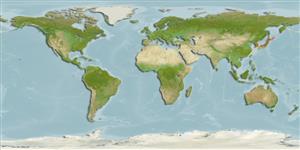Teleostei (teleosts) >
Perciformes/Zoarcoidei (Eelpouts and pricklebacks) >
Stichaeidae (Pricklebacks) > Alectriinae
Etymology: Alectrias: Greek, alektros, -os, -on = single, married in illegal or unhappy marriage (Ref. 45335).
More on authors: Jordan & Snyder.
Environment: milieu / climate zone / depth range / distribution range
Ecology
Marine; demersal; depth range 0 - 20 m (Ref. 50610). Temperate
Northwest Pacific: southern Kuril Islands, Aniva Bay, Japan from Hokkaido to northern Honshu, Japan Sea from Tatar Strait to Korean Peninsula; Yellow Sea at Chefoo and Gulf of Pohai.
Size / Weight / Age
Maturity: Lm ? range ? - ? cm
Max length : 10.0 cm SL male/unsexed; (Ref. 43239); common length : 5.0 cm TL male/unsexed; (Ref. 56557)
Short description
Identification keys | Morphology | Morphometrics
Found in tide pools of rocky shores, among rocks and seaweed beds in bays (Ref. 43239). Oviparous, eggs are guarded by the female parent (Ref. 58332).
Life cycle and mating behavior
Maturities | Reproduction | Spawnings | Egg(s) | Fecundities | Larvae
Masuda, H., K. Amaoka, C. Araga, T. Uyeno and T. Yoshino, 1984. The fishes of the Japanese Archipelago. Vol. 1. Tokai University Press, Tokyo, Japan. 437 p. (text). (Ref. 559)
IUCN Red List Status (Ref. 130435)
Threat to humans
Harmless
Human uses
Tools
Special reports
Download XML
Internet sources
Estimates based on models
Preferred temperature (Ref.
123201): 8.5 - 20, mean 15.2 °C (based on 167 cells).
Phylogenetic diversity index (Ref.
82804): PD
50 = 0.5156 [Uniqueness, from 0.5 = low to 2.0 = high].
Bayesian length-weight: a=0.01000 (0.00244 - 0.04107), b=3.04 (2.81 - 3.27), in cm total length, based on all LWR estimates for this body shape (Ref.
93245).
Trophic level (Ref.
69278): 3.1 ±0.4 se; based on size and trophs of closest relatives
Resilience (Ref.
120179): Medium, minimum population doubling time 1.4 - 4.4 years (Preliminary K or Fecundity.).
Fishing Vulnerability (Ref.
59153): Low vulnerability (10 of 100).
